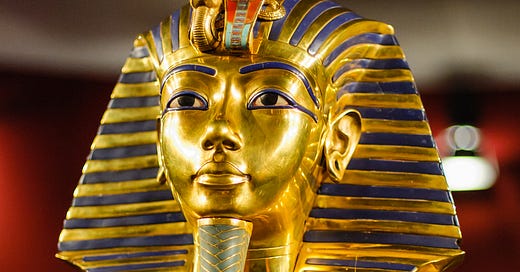The funerary mask of Tutenkhamun has always spoken to me. I saw the real thing in a London exhibition in 1973, immediately bought the poster and had it on my bedroom wall for quite a while. It is so exquisitely beautiful, isn’t it? It has majesty and assurance, grace and kindness. And above all there is his gaze: looking slightly upwards into space, resting on the glories of the afterlife, perhaps.
There is another exhibition of Tutenkhamum in London right now, at the Waterfront, but it has quite a different flavour. It is immersive, using virtual reality technologies in several exhibition rooms to impressive effect. Most of the items under glass are replicas and not genuine antiquities and most of the art that we see, and even the photos that are shown, are projected on to the walls from invisible lights in the ceiling. So in many different ways this exhibition is not anchored in reality at all. It took me on a journey into the world of ancient Egypt by playing with my imagination.
For me, the key to the whole experience, and the thread that brings all the exhibits together, is the mask of Tutenkhamun. I keep coming back to it and gazing into his face as he gazes indirectly into mine. The question that arises in my mind is simple: what do you see? What is it that this glorious ancient king sees through his deep and peaceful gaze? How did he perceive the world? What was his reality?
The exhibition goes some way to answering these very questions. One exhibit brings to life in 3D (with goggles) the chamber in which his mummy was found. On the walls there are paintings meant to guide him in the afterlife. As soon as he woke from the unconsciousness of death he would have seen these paintings with his mind’s eye, and because he was already familiar with them they would have given him his bearings for the soul’s journey after death. How amazing.
Another room and another pair of goggles lets me witness a sequence of events based on the Egyptian Book of the Dead. The deceased goes through a number of landscapes and experiences and if these are negotiated successfully he is taken before a god who sits in judgement on his soul. I found this scene very moving. It is known as the ‘Weighing of the Heart’ ritual. The deceased is led by the god Anubis into the presence of Osiris. There, the dead person swears that he has not committed any sin and his heart is weighed on a pair of scales against the goddess Maat, who embodies truth and justice. Maat was often represented by an ostrich feather, the hieroglyphic sign for her name. So visually, in the exhibition, we watch the scales with a fresh heart on one side and a simple white feather on the other. Will the scales balance? What does it mean, and what does it feel like, to have a heart that is light as a feather?
If the scales balanced, this meant the deceased had led a good life and they would find their place in the afterlife. If the heart was out of balance with Maat, then another fearsome beast called Ammit, the Devourer, stood ready to eat it and put the dead person's afterlife to an early and rather unpleasant end. But in the case of Tutenkhamun, the afterlife was assured.
Reflecting on the exhibition as a whole I came away with a distinct sense that ancient Egyptians did not see the world the way we do. Their culture was not just a matter of reciting mythological stories or perpetuating certain rituals based on those myths; all these cultural manifestations stemmed from the way they actually saw things. They perceived differently and, in particular, they did not merely see ‘what was in front of them’. For example, they saw their pharaohs as gods and then treated them accordingly, with tremendous love and care. The body of Tutenkhamun was placed in a coffin, inside another coffin and so on up to seven different coffins the one housing the other. All this was meaningful because his divine nature was a reality for them, as were all the beings depicted on the walls. And the spells contained in the Book of the Dead were powerful conduits allowing for interaction with beings and forces in another dimension.
What little I know of their wisdom feels quite wholesome to me and fills me with respect. Their civilization began before 3000 BCE and lasted over three thousand years. Notions of modern progress sound quite questionable after an encounter such as this.
Information on the exhibition: https://tutankhamunexperience.com/london/






thank you for sharing... thoughts arise differently with your way of seeing.
Pat